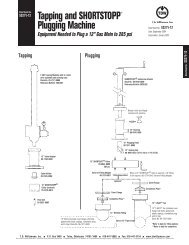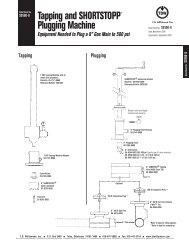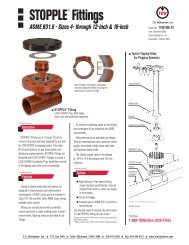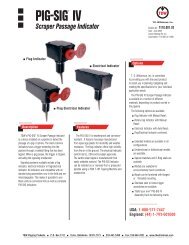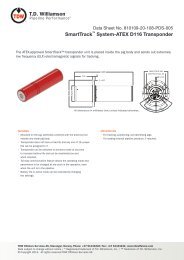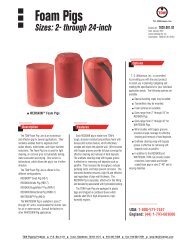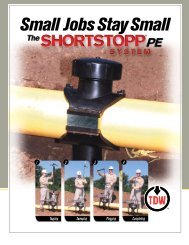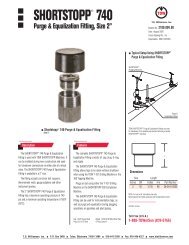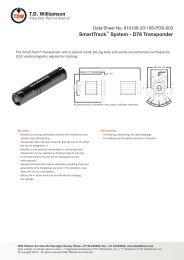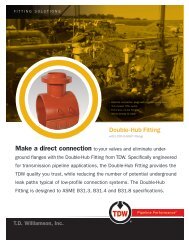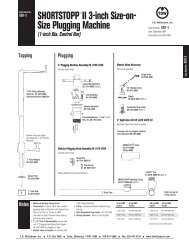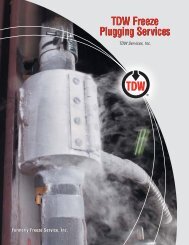White Paper - T.D. Williamson, Inc.
White Paper - T.D. Williamson, Inc.
White Paper - T.D. Williamson, Inc.
You also want an ePaper? Increase the reach of your titles
YUMPU automatically turns print PDFs into web optimized ePapers that Google loves.
2ABSTRACTDouble Block and Bleed (DB&B) is the preferred approach used tomaximize safety while performing piping maintenance. The aim of thepaper is to outline an innovative method of achieving DB&B on gaspipelines.DB&B is traditionally achieved by one of several methods, for example,through using two (2) valves, a valve and a STOPPLE ® plugging head,a STOPPLE ® plugging head and an isolation plug or tandemSTOPPLE ® plugging heads. There are also several DB&B methodswhich utilize inflatable bags or bladders.Developed by T.D. <strong>Williamson</strong> (TDW), the patented STOPPLE ® Trainsystem is a new tool that links together two (2) STOPPLE ® pluggingheads. Only one (1) hot tap is required in the piping for which theSTOPPLE ® Train is inserted. The first STOPPLE ® plugging head is thetrailing plugging head and forms a primary seal. The initial STOPPLE ®plugging head to enter the pipe forms a secondary seal while the backplugging head forms the primary seal. Once sealed, the bleed isaccomplished through a relief port located between the plugging headsallowing downstream maintenance to commence.1.0 INTRODUCTIONOn 20 November 2008, a Texas gas pipeline needed to be replaced.Part of the safety requirements included a DB&B method of pipelineisolation. To add to the complexity of the job, the pipeline was next to avery busy street. Because of rush hour traffic, the pipeline could onlybe repaired between the hours of 9am to 4pm. In addition, otherrequirements of the customer included minimized intrusion into piping,lower fitting, welding Time and associated costs. In response to therequirements and for DB&B isolation, the STOPPLE ® Train pluggingsystem was deployed.2.0 TRADITIONAL METHODS OF DOUBLE BLOCK AND BLEEDIn the past, pipeline operators have used a number of differentmethods to achieve DB&B. For example, two separate valves with ableed port between them can achieve this. Or, the combination of avalve and a plugging head with a port between them can work, as canthe tandem of a plugging head and an isolation plug with a portbetween them. Many operators have simply used two plugging headsand a bleed port. What all of these methods have in common is the
5Figure 4: The STOPPLE ® Train system travels into the pipeline,and the first STOPPLE ® plugging head emerges.Figure 5: Both STOPPLE ® plugging heads emergeand are setting themselves in place.
6Figure 6: Both STOPPLE ® plugging heads are set in placeand DB&B is swiftly obtained.3.1 EQUIPMENT TESTINGThe STOPPLE ® Train system is also robust enough to handle both lowpressure and high pressure environments. Tests have shown that atlow pressures, compression between the sealing elements and thepipe ID creates an excellent barrier. In fact, the sealing element doesnot even need to be energized to seal. At 0.5 psi to 5 psi, thecompression fit alone is sufficient. Once energized, the seal will remainintact until broken by an external force, such as retraction of theplugging head.
7Figure 7: Low Pressure sealing element tests.On the other end of the pressure spectrum, both plugging heads of theFirst Generation STOPPLE ® Train system are rated to 1,000 psi at180°F, or to 600 psi at 350°F. Subsequent generations are fully ratedto ASME Class 600. They have been tested successfully at 1.5 timesthis rating, and the pressurized plugging heads have been successfullytested together and independently.Because the STOPPLE ® Train plugging system requires only one hottap and a standard fitting, fewer potential leak paths are left on thepiping once work is complete. Compared to other methods forachieving DB&B, which typically require twice as many linepenetrations, this represents a major improvement. Fewer fittings alsoresults in less expense.3.2 MAXIMUM SAFETYThis project required DB&B which was driven by safety concerns. Theadded safety of the STOPPLE ® Train system comes from its two seals.With a tap between the two seals, that area can be monitored forleakage before and during work on the pipeline downstream. In theunlikely event that the first seal leaks, the second seal is fully capableof holding the line pressure by itself.
83.3 SUBSTANTIAL SAVINGSAs part of the customer request to reduce costs, the STOPPLE ® Trainplugging system was utilized and met the requirement of providingsubstantial cost savings over other DB&B methods by reducing thenumber of fittings placed on the line. Further savings resulted from lessexcavation, fewer pieces of equipment, less welding and a shorteroverall job time (meaning less exposure to potential hazards forpersonnel).The most cost-effective aspect of this new plugging system stems fromthe fact that it is based on proven technology. Pressure ratings for theSTOPPLE ® Train system follow traditional STOPPLE ® parameters, andall standard STOPPLE ® tools apply to the maintenance of theSTOPPLE ® Train heads. Overall, use of the STOPPLE ® Train pluggingsystem requires nearly identical training, operation and maintenanceas for all STOPPLE ® systems, meaning many experienced users willsee very little change (other than a little extra plugging head travellength) from their typical plugging operations.4.0 ACTUAL FIELD JOBOn 20 November 2008, a Texas gas pipeline needed to be replaced.Part of the safety requirements included a DB&B method of pipelineisolation.On the day of the job, standard pressure tests on the STOPPLE ®Fittings were performed and then the hot taps were made. TheSTOPPLE ® Housing was installed and Blow Down and Equalizationhoses were installed. Sweeping was conducted and the STOPPLE ®Train system was set. The pipe was bled down and the seal wasobtained.
9Figure 8: Project was in the pipeline next to a very busy street.With the STOPPLE ® Train system set in place, cold cutting andwelding of both sections of the pipe were executed and completed. Atthe conclusion of the repairs, the STOPPLE ® Train system wasretracted and the completion plug was set in place.Figure 9: Examination of the sealing elements following the jobshowed lots of chips but no significant damage to either sealing element.
105.0 CONCLUSIONThe STOPPLE ® Train system performed according to expectations.Although hot tapping with no flow through the line left some chips inthe pipe, the sealing elements sealed properly. The secondary sealprevented any gas from leaking into the work area and the bleed portallowed the gas which slipped past the primary seal to be evacuated toa safe location. The project was successfully completed and all of theobjectives and requirements were satisfied.STOPPLE ® is a registered trademark of T.D. <strong>Williamson</strong>, <strong>Inc</strong>. in the United Statesand in foreign countries.© Copyright 2012. All rights reserved by T.D. <strong>Williamson</strong>, <strong>Inc</strong>. Reproduction in wholeor in part without permission is prohibited.



